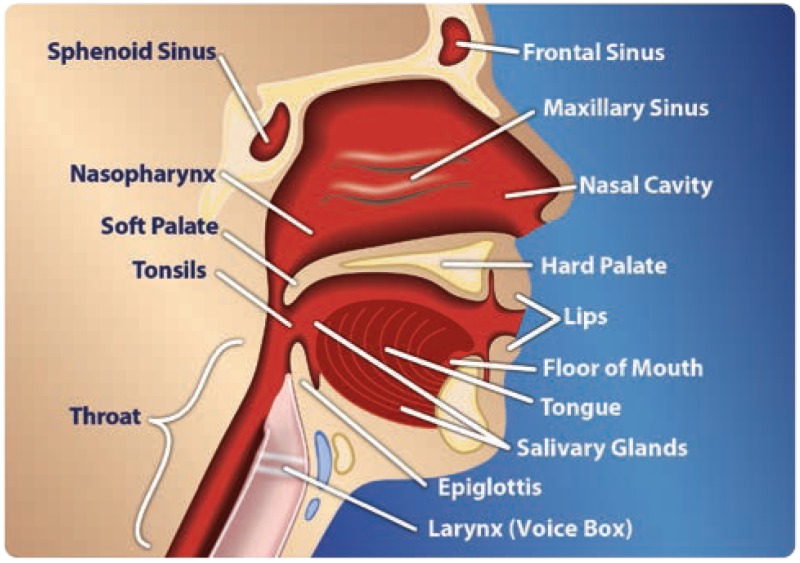NCBI Bookshelf. A service of the National Library of Medicine, National Institutes of Health.
Comparative Effectiveness Review Summary Guides for Consumers [Internet]. Rockville (MD): Agency for Healthcare Research and Quality (US); 2005-.
This publication is provided for historical reference only and the information may be out of date.
Is This Summary Right for Me?
This information may be useful to you if
- Your doctor* said you have head and neck cancer.
- Your doctor suggested radiation therapy.
If you are not sure if this summary is right for you, ask your doctor, nurse, or other health care professional.
What will this summary tell me?
This summary will tell you about
- External-beam radiation therapy (radiation given from a machine outside your body)
- Differences between four ways that external-beam radiation therapy can be given
- Possible side effects of external-beam radiation therapy
This summary does not cover
- Brachytherapy (small radioactive seeds that go inside your body)
- Other treatments for head and neck cancer, such as chemotherapy or surgery
- Radiation therapy for brain cancer or thyroid cancer
Where does the information come from?
The information in this summary comes from a review of many different studies on radiation therapy for head and neck cancer. It is not based on a single study but on many studies. A team of researchers, doctors, and other experts looked at the review.
Understanding Your Condition
What is head and neck cancer?
Head and neck cancer is cancer that forms in or around the nose, mouth, and throat. Most types of head and neck cancer start in the cells lining the sinuses, nasal cavity, mouth, or throat.
Other kinds of head and neck cancer form in the salivary glands. These glands make the fluid, called “saliva” or spit, that keeps your mouth and throat moist. Brain cancer and thyroid cancer are not types of head and neck cancer.
According to the National Cancer Institute, head and neck cancer accounts for nearly 3 to 5 percent of all cancer cases in the United States. Head and neck cancer is more common in men and in people older than age 50. Around 47,560 men and women in the United States get head and neck cancer every year. Tobacco and alcohol use are common risk factors for this cancer.
How is head and neck cancer treated?
There are several ways to treat head and neck cancer, including:
- Surgery: Some or all of the cancer cells are removed.
- Chemotherapy: Certain drugs are used to kill cancer cells.
- Radiation therapy: High-energy radiation beams are used to kill cancer cells in and around the tumor.
Often, these treatments are used together. This summary is only about radiation therapy.
Understanding Radiation Therapy
What is radiation therapy?
Radiation therapy uses high-energy radiation beams to kill cancer cells in and around a tumor.
Radiation therapy works in two ways:
- It can stop or slow the growth of the cancer.
- It can shrink tumors, reduce some symptoms, and relieve pain.
Radiation therapy does not kill cancer cells right away. You may need several days or weeks of radiation therapy before cancer cells start to die. Cancer cells will keep dying for weeks or months after radiation therapy ends.
Radiation therapy starts with a plan
Your doctors will make a detailed plan for your radiation therapy. The plan includes:
- Where to aim the radiation beams
- How much radiation you should get
The goal of the plan is to provide the right amount of radiation to shrink your tumor or stop it from growing. The doctors want to protect you from any harm caused by the radiation, especially to the healthy tissues around the tumor.
Different ways to give external-beam radiation therapy
There are several ways to give external-beam radiation therapy. New radiation therapy machines let doctors better focus the beams on your tumor and lessen the radiation that hits healthy tissues around the tumor. This can be done by sending the radiation beams from different angles or at different strengths. Giving radiation in these ways may help lessen side effects.
The goal is to:
- Target the tumor with the right amount (dose) of radiation
- Limit the radiation that hits healthy organs and other tissues around the tumor
Four ways that external-beam radiation therapy can be given are:
- Three-Dimensional Conformal Radiation Therapy (3DCRT): With 3DCRT, three-dimensional (3D) images help the doctor better target the tumor. The images are created using a special machine — a computed tomography (CT) or magnetic resonance imaging (MRI) machine. The radiation beams can be aimed from many different angles.
- Intensity-Modulated Radiation Therapy (IMRT): IMRT is similar to 3DCRT, but the doctor can adjust how much radiation you get from each beam.
- Stereotactic Body Radiation Therapy (SBRT): SBRT works like 3DCRT and IMRT, and the total amount of radiation you get is similar. But with SBRT, the radiation is given in fewer doses, and each dose is stronger than the doses given with 3DCRT and IMRT.
- Proton-Beam Radiation Therapy (PBRT): With PBRT, the doctor uses a different type of high-energy beam (made of protons rather than x-rays) to treat your tumor. PBRT is not as common as the other ways to give radiation therapy.
What have researchers found about how well the different ways to give radiation therapy work?
Researchers cannot be sure if the way that radiation therapy is given affects how well the radiation stops or slows the growth of head and neck cancer. Researchers also cannot be sure if the way that radiation therapy is given affects how long you live.
What are the side effects of radiation therapy?
Radiation therapy can damage normal, healthy cells near and around your cancer. The damage may cause side effects. These side effects can be very different for different people. Your side effects may depend on:
- The dose and type of radiation used
- The site of your head and neck cancer
- The stage of your head and neck cancer
- Your age
Types of side effects
Side effects can appear around 2 weeks after the first radiation treatment or much later and can include:
- Mouth sores (ulcers in your mouth)
- Dry mouth
- Pain or difficulty swallowing
- Changes in taste or smell
- Changes in the sound of your voice
- Jaw stiffness and other problems with your jaw bone
- Changes in your skin
- Feeling tired
What have researchers found about how radiation therapy is given and side effects?
Researchers do not know much about how side effects may differ for the different ways that radiation therapy can be given. There is only enough research to know about one side effect — dry mouth.
Radiation therapy can damage the salivary glands (the glands that make saliva, or spit). This can affect how much saliva is made and can lead to dry mouth. Researchers have found that the risk of dry mouth is much lower with IMRT than with 3DCRT. Also, patients treated with IMRT had a better quality of life related to dry mouth when compared with patients treated with 3DCRT.
Saliva is important for many things, and dry mouth can greatly affect quality of life. Saliva is needed as you eat to help you swallow your food. It also helps protect you from tooth decay and tongue and gum diseases by keeping bacteria from settling on your teeth, tongue, and gums. Saliva even plays a role in speaking.
Talking With Your Doctor
You may want to talk with your doctor about:
- Your options for external-beam radiation therapy
- Which option might be best for you
- Possible side effects
Ask your doctor
- What are my options for external-beam radiation therapy?
- Which option do you think is best for me?
- What side effects am I most likely to have?
- When might the side effects start? How long might they last?
- When should I tell you about any side effects?
- What can we do about any side effects?
Sources
The information in this summary comes from the report Radiotherapy Treatments for Head and Neck Cancer Update (2014). It was written by the Blue Cross and Blue Shield Association Evidence-based Practice Center. It is an update of a 2010 report, Comparative Effectiveness and Safety of Radiation Therapy Treatments for Head and Neck Cancer, by the Blue Cross and Blue Shield Association Technology Evaluation Center Evidence-based Practice Center.
For a copy of the 2014 report or for more information about the Agency for Healthcare Research and Quality, go to www.effectivehealthcare.ahrq.gov/head-neck-cancer.
Additional information came from the MedlinePlus® Web site, a service of the National Library of Medicine and the National Institutes of Health. This site is available at www.nlm.nih.gov/medlineplus.
This summary was prepared by the John M. Eisenberg Center for Clinical Decisions and Communications Science at Baylor College of Medicine, Houston, Texas. People with head and neck cancer reviewed this summary.
Footnotes
- *
In this summary, the term doctor refers to your health care professional, including your primary care physician, otolaryngologist (ear, nose, and throat specialist), oncologist, nurse practitioner, or physician assistant.
- Review Understanding Radiotherapy for Head and Neck Cancer: A Guide for Adults and Their Caregivers.[Comparative Effectiveness Revi...]Review Understanding Radiotherapy for Head and Neck Cancer: A Guide for Adults and Their Caregivers.John M. Eisenberg Center for Clinical Decisions and Communications Science. Comparative Effectiveness Review Summary Guides for Consumers. 2005
- Incidence of primary hypothyroidism in patients exposed to therapeutic external beam radiation, where radiation portals include a part or whole of the thyroid gland.[Indian J Endocrinol Metab. 2012]Incidence of primary hypothyroidism in patients exposed to therapeutic external beam radiation, where radiation portals include a part or whole of the thyroid gland.Laway BA, Shafi KM, Majid S, Lone MM, Afroz F, Khan S, Roohi R. Indian J Endocrinol Metab. 2012 Dec; 16(Suppl 2):S329-31.
- Proton Beam Therapy for Cancer in Children and Adults: A Health Technology Assessment.[Ont Health Technol Assess Ser....]Proton Beam Therapy for Cancer in Children and Adults: A Health Technology Assessment.Ontario Health (Quality). Ont Health Technol Assess Ser. 2021; 21(1):1-142. Epub 2021 May 6.
- Treatment of head and neck paragangliomas with external beam radiation therapy.[Int J Radiat Oncol Biol Phys. ...]Treatment of head and neck paragangliomas with external beam radiation therapy.Dupin C, Lang P, Dessard-Diana B, Simon JM, Cuenca X, Mazeron JJ, Feuvret L. Int J Radiat Oncol Biol Phys. 2014 Jun 1; 89(2):353-9. Epub 2014 Mar 27.
- Review Antipsychotic Medicines for Treating Schizophrenia and Bipolar Disorder: A Review of the Research for Adults and Caregivers.[Comparative Effectiveness Revi...]Review Antipsychotic Medicines for Treating Schizophrenia and Bipolar Disorder: A Review of the Research for Adults and Caregivers.John M. Eisenberg Center for Clinical Decisions and Communications Science. Comparative Effectiveness Review Summary Guides for Consumers. 2005
- Radiation Therapy for Head and Neck Cancer - Comparative Effectiveness Review Su...Radiation Therapy for Head and Neck Cancer - Comparative Effectiveness Review Summary Guides for Consumers
- ATP synthase F0 subunit 9 (mitochondrion) [Sargassum fluitans]ATP synthase F0 subunit 9 (mitochondrion) [Sargassum fluitans]gi|1133409834|ref|YP_009340756.1|Protein
- Securinega durissima trnK gene, partial sequence; and maturase K (matK) gene, co...Securinega durissima trnK gene, partial sequence; and maturase K (matK) gene, complete cds; chloroplastgi|61968388|gb|AY830285.1|Nucleotide
- Reverchonia arenaria trnK gene, partial sequence; and maturase K (matK) gene, co...Reverchonia arenaria trnK gene, partial sequence; and maturase K (matK) gene, complete cds; chloroplastgi|61968378|gb|AY830280.1|Nucleotide
Your browsing activity is empty.
Activity recording is turned off.
See more...

